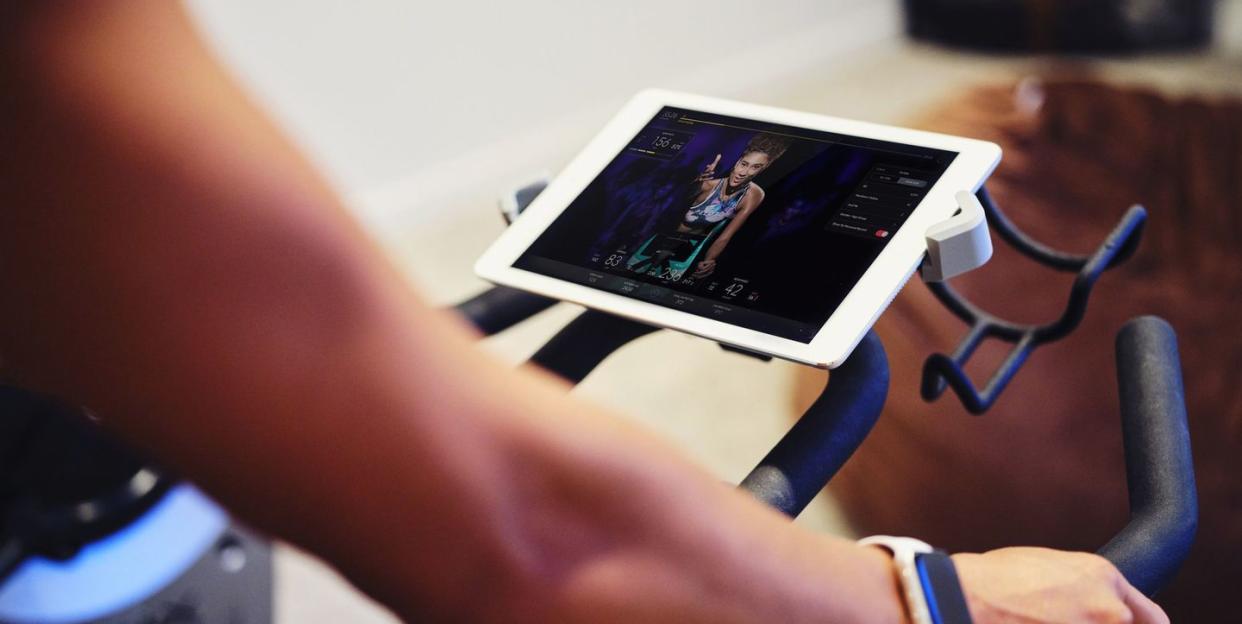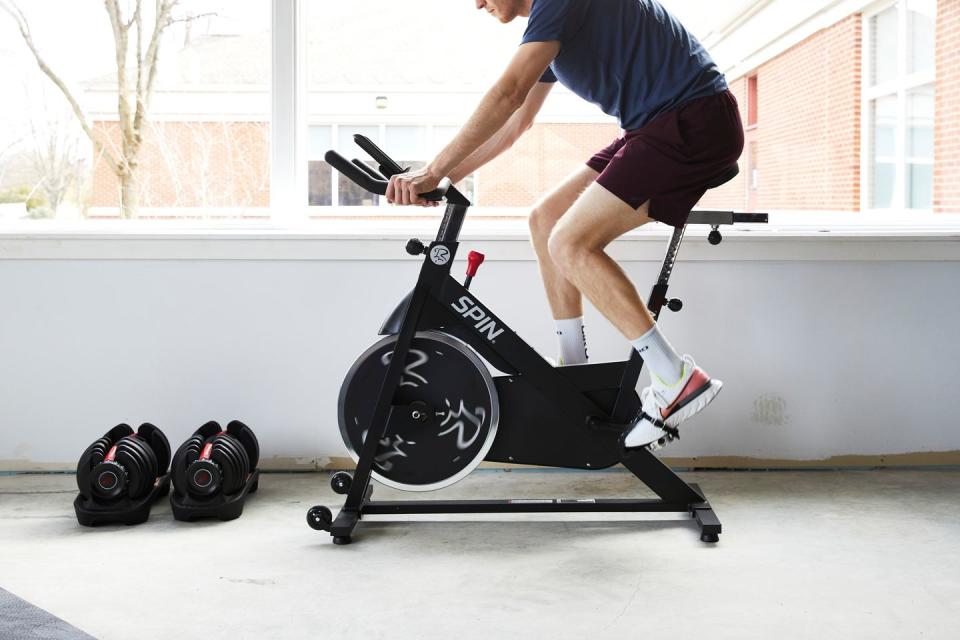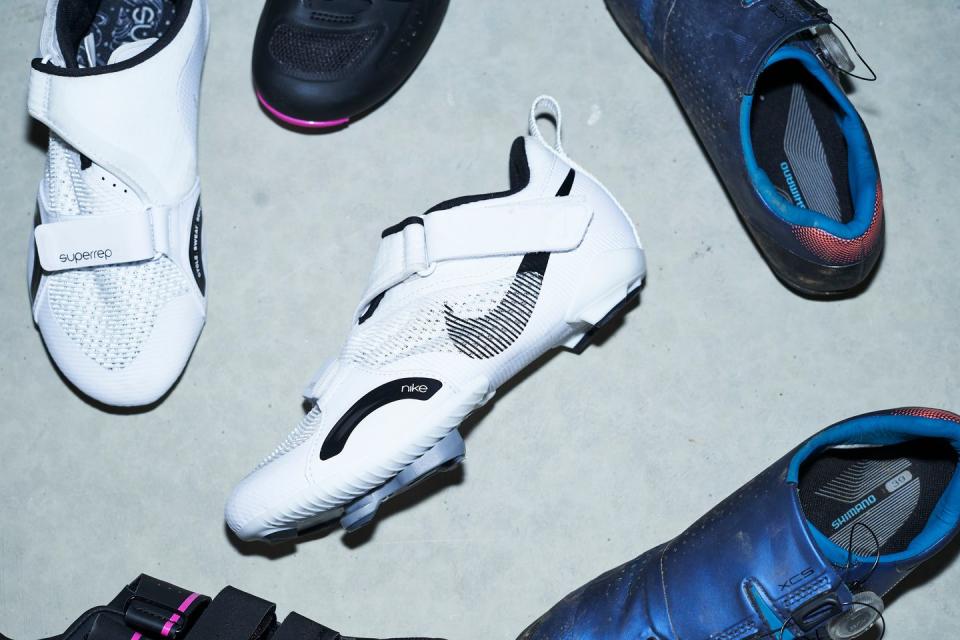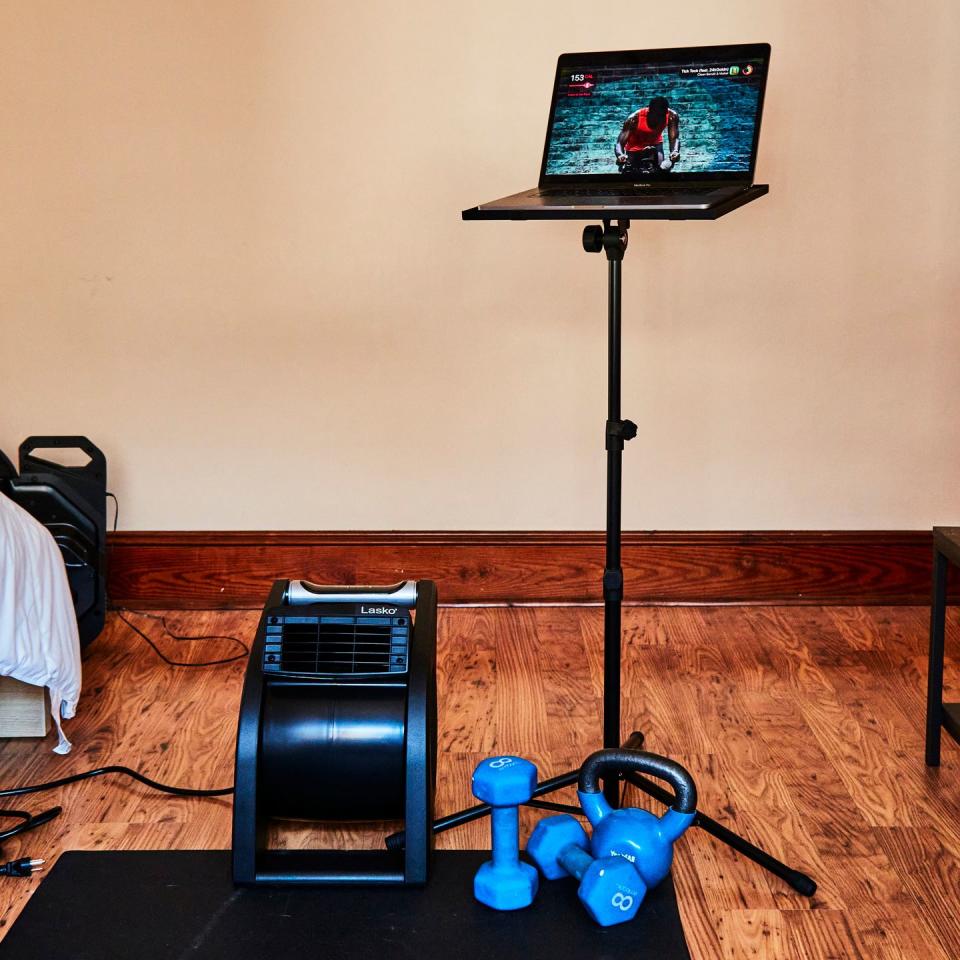Want a Peloton But Don’t Want to Break Your Bank? This DIY Setup Says Hello

"Hearst Magazines and Yahoo may earn commission or revenue on some items through the links below."
Throughout the course of the coronavirus pandemic, working out at home has become the norm. And while high-tech stationary bikes like Peloton or SoulCycle are trendy and tempting to add to your home gym, the costs can add up.
Join Bicycling All Access today for more at-home workout hacks!
The bikes themselves come with a hefty price tag—often ranging from around $1,400 to $2,900—and you have to tack a membership subscription on top of that. Then there are accessories you can get to supplement your indoor cycling experience, such as shoes, hand weights, a mat, and resistance bands to name a few.
But you don’t have to break the bank to break a sweat at home. You can actually get the full Peloton—or other indoor cycling class of choice—experience at home for a fraction of the cost, starting at around $300 (plus a low monthly app subscription fee). Here’s how.
Bike

Price range: $300 to $1000
Maybe you want the most affordable, no-frills bike, because you don’t care about the latest bike tech or ride metrics, and you just want a simple way to pedal along to Peloton workouts. (You’ll have to estimate instructor cues on cadence, resistance level, etc., but some are okay with that!) All you really need then is a smartphone (or tablet, computer, or smart TV to stream the app) and a pair of shoes.
If you do want some bike tech, first, think about the types of classes you plan to take. Many are structured around cadence, resistance, and power. So if you’re a metrics person, you’ll want a bike with a display screen that shows ride stats like time elapsed, estimated calories burned, RPM (cadence), resistance level, speed, etc.
Some stationary bikes come with a power meter built-in, but they’re often expensive. So if you go for a more affordable stationary bike that doesn’t measure any metrics, like the Sunny bike we list below, you could always add an aftermarket cadence sensor ($20 or more) or power meter (at least $300, likely more). And if you’re looking to pair other apps, fitness trackers, or your tablet to the bike, you’ll need a bike with Bluetooth.
Alternatively, if you already have a bicycle at home—be it a road, mountain, commuter, or other bike—you could simply buy an indoor bike trainer and use that instead. You could either get a basic bike trainer or a “smart” trainer with Bluetooth/ANT+ capability, depending on your needs. The only downside of going this route is that you won’t have a weighted flywheel for resistance like on a standard stationary bike, and you might not be able to perform certain moves out of the saddle.
Setup Considerations
Price range: $30 and up (optional)
Many bikes come with a tablet holder, but consider how you will use the apps. If you get a bike without a device holder on the handlebar, you can get an attachment to hold it or you can cast the app to your TV. A tablet provides a more immersive riding experience than a phone and is more accessible (since it’s right in front of you) than a TV, but a TV will provide the largest visual.
And, while most bikes have a holder or two for a water bottle, if you have a designated bike area, you may want to consider mounting a shelf on the wall to hold your phone, extra sweat towels, or anything else you might want close at hand. Otherwise, you could utilize a small table, stand, or stool.
Shoes

Price range: $65 and up
Many new indoor cycling bikes come with pedals that have toe cages (also known as toe clips) that only require sneakers, and you can adjust the fit by tightening the straps. That can work just fine, but you might want to upgrade your setup with cycling-specific shoes, which can clip into the pedals.
Cycling shoes enable you to feel more stable on the bike without worrying about slipping out of the toe cages, comfortably transition in and out of the saddle, and transfer more power to your pedal stroke. One note: you’ll want to check your pedals to ensure you get the right cleat-pedal combo. Many stationary bikes come with pedals that are SPD compatible in addition to having toe cages, while some (like on Peloton bikes) may only be Delta compatible.
SPD cleats attach to the shoe using two bolts, while Delta cleats use three bolts. Some cycling shoes are compatible with both—and have both a two-bolt mounting pattern and a three-bolt pattern on the sole—while some are specific to one style. SPD-style shoes, such as mountain bike shoes, tend to be easier to walk in since the cleats are recessed into the sole.
Check out our full guide on the best indoor cycling shoes. And after you pick up a pair, head on over to our guide on how to set up indoor cycling shoes.
Apps
Price range: $10/month and up
Creating a DIY indoor cycling studio gives you the freedom to use any app that you want rather than being locked into the one that pairs with an expensive bike. And there are plenty to choose from these days. Many apps offer a free trial so you can test it out to figure out exactly what you like before financially committing.
Peloton offers two membership levels: an all-access membership for $39 a month or a digital membership for $13 a month. However, the all-access plan is only available to users who own a Peloton bike or treadmill. Using an off-brand bike means you’ll use the more affordable digital membership. While you will have access to all of the same classes as Peloton bike owners, you won’t have access to leaderboards and other features like personalized playlists, community interaction, or connectivity like “auto-follow” which allows the bike to automatically adjust to the trainer-led resistance, and you won’t have the ability to create separate accounts for others at home.
You don’t have to go with Peloton, though. There are other comparable indoor cycling and workout apps available. We’ve rounded up our favorites and those highest ranked by app users below, along with how much they cost and what’s included.
Accessories

Price range: $15 and up; likely $100
In the end, the only items you technically need in order to set up your own DIY Peloton studio at home is a bike, an app subscription, and a way to view the classes. That being said, some additional (and often wallet-friendly) accessories can really improve your indoor cycling experience. Here’s what we recommend.
Bike mat: Consider where you plan to put your bike. Depending on your flooring (Do you have carpet? Do you need to protect hardwood?), you’ll likely want a thick mat under the bike to keep your floor scuff-free and protected from dripping sweat that’s sure to pour off you midride. Some bike mats are designed to absorb noise too, for a quieter ride.
Weights: Some indoor cycling classes feature an “arms” portion that involves upper body work with weights. Some bikes come with a set, but you may want to invest in a range of weights.
Sweat towel: After you get warmed up and start crushing intervals and climbs, the sweat will be flowing. Having a sweat towel on hand is essential—it’ll keep the sweat out of your eyes and help mitigate pools of sweat from forming on your floor.
Fan: Even if you have a sweat towel, riding inside is nothing like being outdoors, aka, no moving air. A fan is key to providing a breeze and some relief when you start heating up.
Water bottle: Sure, a glass of water will do, but when you’re sweating up a storm and need to take a swig midride, a cycling-specific water bottle is the best option. It’s easier to drink from while riding, easier to grasp, and it minimizes spillage if you do drop it. Plus, most bikes have a designated water bottle holder for easy access.
Headphones: If you live in an apartment complex or with multiple people, you may want to invest in a pair of Bluetooth headphones so you can listen to music and instructors without disturbing anyone else. There are plenty of great “sweatproof” options.
Total Cost:
In the end, and depending on what you already have, you can build a DIY Peloton-style setup at home for as low as $400 to upwards of around $1,200 plus the cost of a monthly membership. Considering the cost of a Peloton bike is $1,895 to $2,495, that’s a pretty good cost saving for home workouts that keep you engaged and inspired.
You Might Also Like

